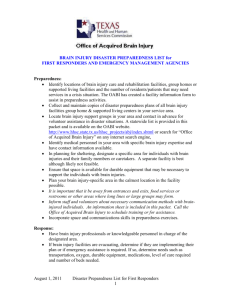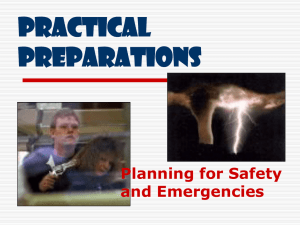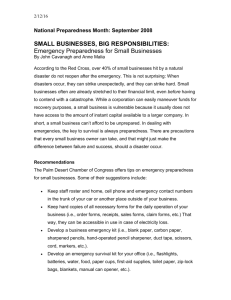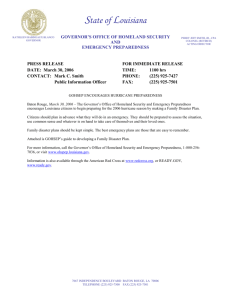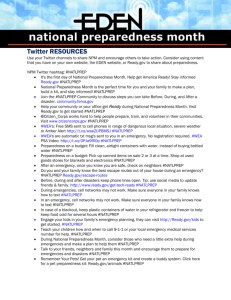Word - Bridge Multimedia
advertisement
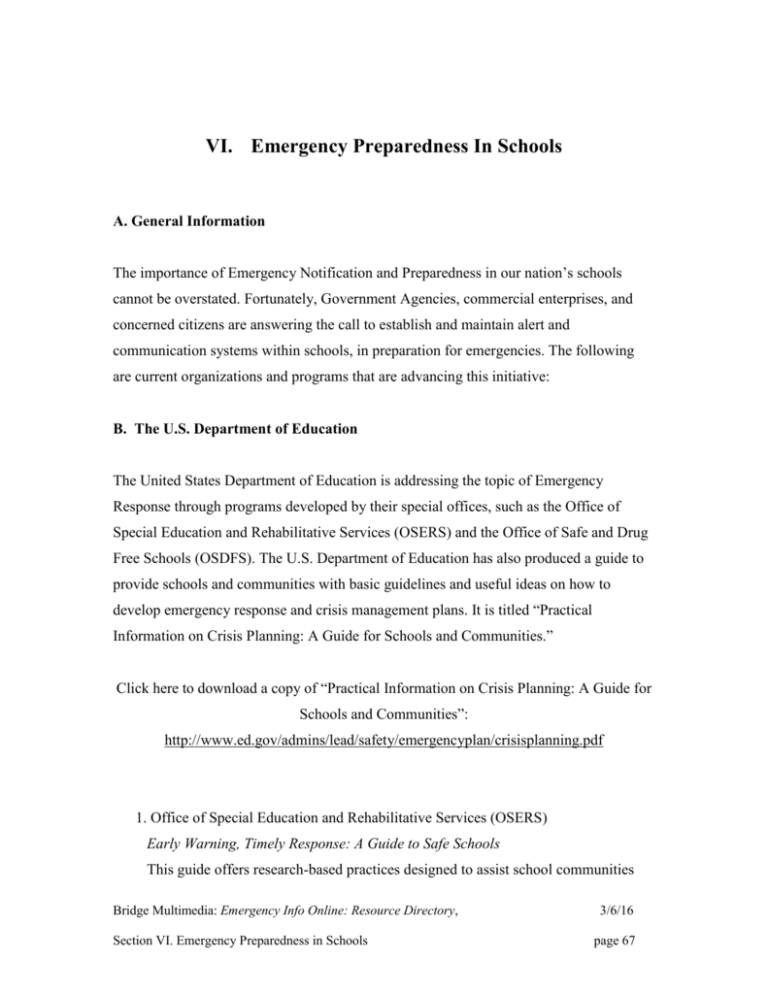
VI. Emergency Preparedness In Schools A. General Information The importance of Emergency Notification and Preparedness in our nation’s schools cannot be overstated. Fortunately, Government Agencies, commercial enterprises, and concerned citizens are answering the call to establish and maintain alert and communication systems within schools, in preparation for emergencies. The following are current organizations and programs that are advancing this initiative: B. The U.S. Department of Education The United States Department of Education is addressing the topic of Emergency Response through programs developed by their special offices, such as the Office of Special Education and Rehabilitative Services (OSERS) and the Office of Safe and Drug Free Schools (OSDFS). The U.S. Department of Education has also produced a guide to provide schools and communities with basic guidelines and useful ideas on how to develop emergency response and crisis management plans. It is titled “Practical Information on Crisis Planning: A Guide for Schools and Communities.” Click here to download a copy of “Practical Information on Crisis Planning: A Guide for Schools and Communities”: http://www.ed.gov/admins/lead/safety/emergencyplan/crisisplanning.pdf 1. Office of Special Education and Rehabilitative Services (OSERS) Early Warning, Timely Response: A Guide to Safe Schools This guide offers research-based practices designed to assist school communities Bridge Multimedia: Emergency Info Online: Resource Directory, Section VI. Emergency Preparedness in Schools 3/6/16 page 67 identify these warning signs early and develop prevention, intervention and crisis response plans. The document was based on the work of an independent panel of experts in the fields of education, law enforcement, and mental health. The guide includes sections on: a. Characteristics of a School that is Safe and Responsive to All Children b. Early Warning Signs c. Getting Help for Troubled Children d. Developing a Prevention and Response Plan e. Responding to Crisis f. Resources g. Methodology, Contributors, and Research Support Early Warning, Timely Response: A Guide to Safe Schools can be downloaded at: http://cecp.air.org/guide/guide.pdf 2. Office of Safe and Drug-Free Schools Emergency Planning As schools and communities across the U.S. prepare and develop plans for responding to potential emergency situations, the Office of Safe and Drug-Free Schools has unveiled a new web resource to help. It is designed to be a one-stop shop that provides school leaders with information they need to plan for any emergency, including natural disasters, violent incidents and terrorist acts. The site will be regularly updated. The Emergency Planning site can be found at: http://www.ed.gov/emergencyplan Emergency Response and Crisis Management Plan Discretionary Grants Funds will be available to local education agencies to strengthen and improve emergency response and crisis management plans. The funding forecast, as of Bridge Multimedia: Emergency Info Online: Resource Directory, Section VI. Emergency Preparedness in Schools 3/6/16 page 68 11/28/05: Estimated average size of awards: $100,000-$500,000 Number of awards: 73 Application deadline: May 21, 2007 CFDA Number: 84.184E For more grant information, click here http://www.ed.gov/programs/dvpemergencyresponse/index.html C. The National Clearinghouse for Educational Facilities (NCEF) The National Clearinghouse for Educational Facilities (NCEF) was established in 1997, by the U.S. Department of Education, as a free public service to provide information on planning, designing, funding, building, improving, and maintaining schools. NCEF is managed by the National Institute of Building Sciences (NIBS), which was authorized by Congress in 1974 to serve as a non-profit, non-governmental, authoritative source on building science and technology. The National Clearinghouse for Educational Facilities has directed a considerable amount of attention towards the important problem of disaster preparedness and response for schools. NCEF's maintains a resource list of links, books, and journal articles on building or retrofitting schools to withstand natural disasters and terrorism, developing emergency preparedness plans, and using school buildings to shelter community members during emergencies. Some highlights from this list include: 1. Homeland Security for Schools: Threat Status Alert Worksheet This worksheet includes suggested actions for schools based on general recommendations from the Homeland Security Department. Bridge Multimedia: Emergency Info Online: Resource Directory, Section VI. Emergency Preparedness in Schools 3/6/16 page 69 Click here to download the worksheet: http://www.schoolsafety.us/pubfiles/color_coded_alert_system_for_schools.pdf 2. Disaster Recovery: The Time is Now. Reviews the Hurricane Katrina experiences of some prepared (and unprepared) higher education institution technology departments, suggests steps for developing a disaster recovery plan, describes a pan-departmental disaster team, and types of backups. Click here to download “Disaster Recovery: The Time Is Now” http://www.campus-technology.com/print.asp?ID=11974 3. DisasterHelp.gov DisasterHelp.gov is designed to assist victims of disasters in locating the information and services they need. The goal of the site is to combine the disaster management resources of all the federal agencies in its partnership in one central location. Click here to visit DisasterHelp.gov: https://disasterhelp.gov/portal/jhtml/index.jhtml 4. How Schools Can Become More Disaster Resistant. Resources for Parents and Teachers. FEMA recommends the following actions for all school officials: 1) Identify hazards likely to happen to your schools; 2) Mitigate against the hazards; 3) Develop a response plan, including evacuation route; 4) Plan for coping after a disaster; and 5) Implement drills and family education. Click here to visit FEMAs “How Schools Can Become More Disaster Resistant: Resources for Parents and Teachers”: Bridge Multimedia: Emergency Info Online: Resource Directory, Section VI. Emergency Preparedness in Schools 3/6/16 page 70 http://www.fema.gov/kids/schdizr.htm 5. The Preparedness of Schools to Respond to Emergencies in Children: A National Survey of School Nurses. This document examines the preparedness of schools to respond to pediatric emergencies and potential mass disasters, using published guidelines from the American Academy of Pediatrics and the American Heart Association. Click here to download “The Preparedness of Schools to Respond to Emergencies in Children: A National Survey of Nurses: http://pediatrics.aappublications.org/cgi/content/full/116/6/e738#ABS For NCEF’s Preparedness Resource List Please Click Here http://www.edfacilities.org/rl/disaster.cfm D. The Emergency Response and Crisis Management Technical Assistance Center In October 2004, the U.S. Department of Education's Office of Safe and Drug-Free Schools, (OSDFS) established the Emergency Response and Crisis Management Technical Assistance Center to disseminate information about emergency response and crisis management in order that school districts learn more about developing, evaluating, and implementing, crisis plans. The Center also helps the OSDFS coordinate technical assistance meetings, manage a listserv for sharing crisis planning information and respond to direct requests for technical assistance. For More Information Please Click Here http://www.ercm.org/ Bridge Multimedia: Emergency Info Online: Resource Directory, Section VI. Emergency Preparedness in Schools 3/6/16 page 71 E. Multi-Hazard Emergency Planning for Schools FEMA has developed an eight hour independent study program entitled IS-362 MultiHazard Emergency Planning for Schools. It is a short and “easy to take” web-based course that focuses on emergency preparedness and planning for schools. The course describes emergency management operations, roles and duties; explains how to assess potential hazards that schools may face; explains how to develop and test an Emergency Operations Plan that addresses all potential hazards. This course is designed for school administrators, principals, and first responders. However, parents, teachers, volunteers, anyone with a personal or professional interest in school preparedness is welcome to participate. Upon finishing the course, any student wishing to obtain a “Certificate of Completion” will need to successfully submit and pass a final exam. Multi-Hazard Emergency Planning for Schools covers the following topics: Lesson 1: Course Overview Lesson 2: Understanding Emergency Management Lesson 3: Recruiting Your Planning Team Lesson 4: Assessing Your Hazards Lesson 5: Developing Your Plan Lesson 6: Planning for Terrorism Lesson 7: Training and Testing Your Plan Lesson 8: Course Summary and Test For More Information, Please Click Here http://training.fema.gov/EMIWeb/IS/is362.asp F. The Community Emergency Response Network (CERN) Bridge Multimedia: Emergency Info Online: Resource Directory, Section VI. Emergency Preparedness in Schools 3/6/16 page 72 Howard County's Community Emergency Response Network (CERN) was created to facilitate the development of a community-based disaster response plan for Howard County, Maryland, to guarantee maximum readiness in the event of a terrorist attack. This unique community emergency preparedness program was initiated after September 11, as a partnership between the Horizon Foundation, the County government, and important community agencies in Howard County. The effort supports government disaster planning through coordination of the emergency plans and resources of participating members. CERN functions include planning, a high level of inter-agency coordination, the development of tabletop exercises, disaster plan review, shelter planning and communications enhancement. Howard County’s Public School System plays an important role in the CERN program. The School Information page on CERN’s website provides information concerning emergency notification, EAS broadcast stations and other local news media, emergencyrelated school procedures, and parent’s responsibilities during an emergency. According to the website: “In addition to inclement weather, recent events accentuate the need for parental awareness of school safety procedures. Emergencies have the potential to affect only one building or a number of school facilities. A large regional incident might require a system-wide response. Our schools have plans in place that anticipate many kinds of emergencies. We are continuously upgrading these procedures.” For More Information on CERN, Please Click Here http://www.cern.us/ For CERN’s School Information Page, Please Click Here http://www.cern.us/schoolinformation.html For Info on Howard County’s School Emergency Response Plan, Click Here http://www.howard.k12.md.us/abouthcpss/emergency.html Bridge Multimedia: Emergency Info Online: Resource Directory, Section VI. Emergency Preparedness in Schools 3/6/16 page 73 G. School’s Out School's Out is a business that was founded ten years ago by concerned parents in Maryland, who were unable to obtain information regarding early dismissals during Hurricane Fran. Since then, School’s Out has grown into a highly regarded company that works closely with schools, universities, child care centers and community groups to broadcast unscheduled closings, early dismissals and other pertinent information as soon as it becomes available. Schools’ Out provides a service, for 12.95 per year, so that whenever your school has urgent or important information to announce an official school administrator will send a detailed alert directly to your mobile phone. As a subscriber, your phone will ring with the alert within seconds or minutes of the news release. In the past few years, School's Out has helped distribute vital real-time information to the public during snowstorms, hurricanes, wind and ice storms, floods, power failures, and even heating and air conditioning failures. School's Out has also played a role in the notification of Homeland Security risk levels due to terrorist activity, and school lockdowns due to the Washington, D.C. area sniper attacks. For More Information about School’s Out, Please Click Here http://www.schoolsout.com/ H. School Accessibility Resources This heading contains additional information regarding schools and accessibility. These accessibility resources have been gathered together, in this separate section, to provide easy availability to those for whom accessibility is a foremost concern. 1. Creating Accessible Schools http://www.edfacilities.org/pubs/accessibility.html The National Clearinghouse for Educational Facilities’ website that examines issues surrounding federal mandates to accommodate students with disabilities, Bridge Multimedia: Emergency Info Online: Resource Directory, Section VI. Emergency Preparedness in Schools 3/6/16 page 74 including the requirements of the Americans with Disabilities Act (ADA), the Individuals with Disabilities Education Act (IDEA), Section 504 of Title V of the Rehabilitation Act, and advisory guidelines from the U.S. Architectural and Transportation Barriers Compliance Board. 2. Inside Gallaudet: How Can Deaf and Hard of Hearing People Know About Emergencies? http://news.gallaudet.edu/index.asp?ID=965 Gallaudet University’s webpage offers a link to the National Association of the Deaf’s website, as well as a link to a free pager/email service to access varrious types of emergency information from local, regional and national government sources. 3. Emergency Preparedness for Children With Special Health Care Needs http://www.aap.org/advocacy/epcovrltr.htm The American Academy of Pediatrics and the American College of Emergency Physicians’ downloadable form, designed to assure prompt and appropriate care for Children with Special Health Care Needs. This form is to be filled out and filed at a child’s school in case of an emergency. The child’s complicated medical history is concisely summarized and available when it is needed most – during an emergency when neither parent nor pediatrician is immediately available. Bridge Multimedia: Emergency Info Online: Resource Directory, Section VI. Emergency Preparedness in Schools 3/6/16 page 75



